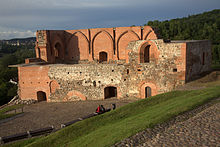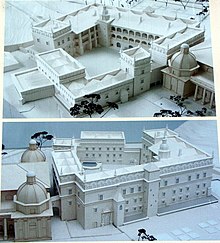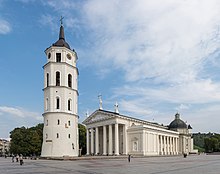Vilnius Castle Complex
| Vilnius Castle Complex | |
|---|---|
| Lithuania | |
| Site information | |
| Controlled by | Lithuania, Russia, Sweden |
| Site history | |
| Built | Parts of castle in 10th century |
| In use | For defense from 10th-17th centuries |
| Materials | Stone, bricks, wood |
The Vilnius Castle Complex (
The complex consisted of three castles: the Upper, the Lower, and the Crooked (
Today, the remaining
History of the Upper Castle
One part of the castle complex, which was built on the top, is known as the Upper Castle. The hill on which it is built is known as the
Archaeological data shows that the site has been occupied since


Pagan Lithuania waged

At the time of the 1390 attack, the Complex consisted of three sections - the Upper, Lower and Crooked Castles. The Teutonic Knights managed to take and destroy the Crooked Castle, situated on Bleak Hill (
The civil war between Vytautas and Jogaila was resolved by the 1392

The Upper Castle was reconstructed in

After the 16th century, the Upper Castle was not maintained, and it suffered from neglect. Until the early 17th century, a prison for noblemen was located in the Upper Castle. It was used as a fortress for the last time during the invasion of the Russians in 1655, when for the first time in Lithuanian history, a foreign army captured the entire complex.[3] Six years later, the Polish–Lithuanian army managed to recapture Vilnius and the castles. Afterwards the Upper Castle stood abandoned and was not reconstructed.[citation needed]
The complex suffered major damage during the
History of the Lower Castle
The Castle Complex has been inhabited since Neolithic times. Prior to the 13th century, its structures were built from wood. In the 13–14th centuries defensive walls, towers and gateways were built from stone; these were reorganized and expanded several times. The only freestanding structures that remain intact are those at the Lower Castle.[citation needed]
The two principal buildings of the Lower Castle are the Royal Palace and Vilnius Cathedral.[citation needed]
Grand Ducal Palace


The Grand Ducal Palace in the Lower Castle evolved over the years and prospered during the 16th and mid-17th centuries. For four centuries the Palace was the political, administrative and cultural center of the Grand Duchy of Lithuania.[4]
In the 13th and 14th centuries there were
The Grand Duke of Lithuania
Sigismund's son
The palace was remodeled in the Renaissance style in the 16th century. The plan was prepared by several Italian architects, including Giovanni Cini da Siena, Bernardino de Gianotis, and others. The palace was visited by Ippolito Aldobrandini, who later became Pope Clement VIII. Another major development took place during the reign of the Vasa family. The Royal Palace was refurbished in early Baroque style during the rule of Sigismund III Vasa. Matteo Castello, Giacopo Tencalla, and other artists participated in the 17th-century renovation.[citation needed]

During the rule of Vasas, several notable ceremonies took place in the palace, including the wedding of Duke John, who later became King John III of Sweden, and Sigismund Augustus' sister Catherine. The first opera in Lithuania was staged in the palace in 1634.[18] Marco Scacchi and Virgilio Puccitelli were the opera's impresarios.[citation needed]
After the Russian invasion in 1655, the state began weakening, with negative effects on the Royal Palace. The palace was greatly damaged by war, and its treasures were plundered. After the recapture of the city of Vilnius in 1660-1661, the palace was no longer a suitable state residence, and stood abandoned for about 150 years. In the late 18th century, after the fall of the Polish–Lithuanian Commonwealth, several families lived in parts of the ruined palace. Soon after the Grand Duchy of Lithuania was incorporated into the
The Seimas (Lithuanian Parliament) passed a law in 2000 resolving that the Royal Palace be rebuilt for ceremonies commemorating the millennium since the first mention of the name of Lithuania in 2009.[19]
Vilnius Cathedral

The grand ducal palace and Vilnius Cathedral formed a complex and stood side by side during the centuries, but the two buildings have different histories.[20]
There is evidence that in pre-
In 1387, the year that Lithuania formally converted to Christianity, a second Gothic cathedral with five chapels was built. In 1419 the cathedral burned down. In its place Vytautas built a larger Gothic cathedral. In 1522, the cathedral was renovated, and written sources mentioned a bell tower for the first time.[16] The bell tower was built on the site of a defensive tower of the Lower Castle around the 15th century. After a fire in 1530, the cathedral was rebuilt again, and from 1534 to 1557 more chapels and crypts were added. During this period the cathedral acquired architectural features associated with the Renaissance. After a fire in 1610, it was rebuilt once again, and the two front towers were added. It was renovated and decorated several more times.[citation needed]

In 1783, the cathedral was reconstructed according to a design by
Several notable historic figures are entombed in the cathedral's crypts, including Vytautas the Great (1430), his brother
The cathedral was converted to secular uses during the 1950s. Its re-dedication as a church in the late 1980s was celebrated as a turning point in modern Lithuanian history.[22][23]
Castle Arsenals

The Vilnius Castle Complex had two
The New Arsenal was established in one of the oldest castle buildings in the 18th century, by order of the

During Tsarist rule, both arsenals housed soldiers and military
Modern developments
Gediminas Tower is a dominant and distinctive object in the skyline of the old city. An observation platform at its summit affords a panoramic view of Vilnius. In 2003, as part of the celebrations surrounding the 750th anniversary of the coronation of Mindaugas, the tower was made more accessible by the construction of a lift. It ascends about 70 meters during the 30-second ride, and holds sixteen passengers.[26] Atop the tower, on January 1, 1919, the Lithuanian tricolor was hoisted for the first time.[1] To commemorate this event, January 1 is now Flag Day, and the Lithuanian flag is ceremonially raised at the tower, as well as elsewhere in Lithuania. On October 7, 1988, during Lithuania's drive to re-establish its independence, 100,000 people gathered at the Castle Complex as the flag was re-hoisted.[23] The tower and the hill, with the flag raised at its summit, are symbols of Lithuania's statehood and its struggle for independence, echoing a long tradition whereby sovereignty over the city was demonstrated by the flag flown there.[6]
After preservation work was completed at the Gediminas Tower in 1968, it became a branch of the National Museum of Lithuania. The first floor of the tower exhibits photographs taken in Vilnius during the 19th and 20th centuries and models of historic Vilnius and the Castle Complex. The second floor exhibits flags that were used by Vytautas the Great's army during the Battle of Grunwald, along with authentic weaponry used from the 13th through the 18th centuries.[citation needed]
Other surviving buildings at the Castle Complex house offices of the National Museum of Lithuania and its
See also
- Cathedral Square in Vilnius
- List of castles in Lithuania
- Pilies Street
- Vilnius Dungeons
References
- In-line:
- ^ a b Lietuvos nacionalinis muziejus (2006). "XIV-XVII a. Vilniaus pilių istorija" (in Lithuanian). Retrieved 2007-01-05.
- ^ a b c Lietuvos muziejų asocijacija (2004). "Lietuvos pilys ir jų panaudojimo kultūriniam turizmui galimybės" (in Lithuanian). Retrieved 2007-01-05.
- ^ ISBN 5-420-00631-6.)
{{cite book}}: CS1 maint: location missing publisher (link - ^ a b Voruta (2003). "Vilniaus Žemutinės pilies Valdovų rūmai" (in Lithuanian). Retrieved 2007-01-05.
- ISBN 1-4020-1298-5.)
{{cite book}}: CS1 maint: location missing publisher (link - ^ ISBN 978-0-8223-3364-7.
- ^ "Visiting Vilnius". Lithuanian Department of Statistics. Archived from the original on 2009-02-27. Retrieved 2009-11-22.
- ^ "Muziejai" (in Lithuanian). Lietuvos nacionalinis muziejus. 31 October 2019. Retrieved 28 March 2024.
- ^ ]
- ISBN 0-521-45011-X.)
{{cite book}}: CS1 maint: location missing publisher (link - ISBN 9955-584-63-7.)
{{cite book}}: CS1 maint: location missing publisher (link - ISBN 1-84176-561-9.)
{{cite book}}: CS1 maint: location missing publisher (link - ISBN 978-90-420-1959-1.
- ^ Napaleonas Kitkauskas (2004). "Italy in Lithuania" (in Lithuanian). Archived from the original on 2007-01-21. Retrieved 2007-01-21.
- ]
- ^ a b Lietuvos Dailės muziejus. "Arkikatedros požemiai" (in Lithuanian). Archived from the original on 2007-01-07. Retrieved 2007-01-21.
- ^ a b Lithuanian Art Museum. (1997). "Lithuanian Ducal Palace" (in Lithuanian). Archived from the original on 2006-12-05. Retrieved 2007-01-21.
- ^ a b Valdovų Rūmų paramos fondas (2002). "Lietuvos Valdovų Rūmai" (in Lithuanian). Retrieved 2007-01-21.
- ^ a b c "History of the Royal Palace". Castle Research Center. Retrieved 2009-11-23.
- ISBN 1-4134-6469-6.)
{{cite book}}: CS1 maint: location missing publisher (link - ^ a b Lietuvos dailės muziejus. "Senieji kultūriniai sluoksniai" (in Lithuanian). Archived from the original on 2007-01-07. Retrieved 2007-01-21.
- ISBN 978-0-8133-3752-4.
- ^ a b "Chronology of Seminal Events Preceding the Declaration of Lithuania's Independence". Lituanus. Retrieved 2009-11-23.
- ^ a b Lietuvos nacionalinis muziejus (2006). "Senasis arsenalas" (in Lithuanian). Retrieved 2007-01-21.
- ^ Museum of Applied Art (2006). "The Old Arsenal". Archived from the original on 2011-07-19. Retrieved 2007-01-05.
- ^ XXI amžius (2003). "Į Gedimino kalną - keltuvu" (in Lithuanian). Retrieved 2007-01-25.
- ^ a b Lituvos nacionalinis muziejus (2006). "Muziejaus istorija" (in Lithuanian). Retrieved 2007-01-25.
- General:
- (in Lithuanian) Ragauskienė, R.; Antanavičius, D.; Burba, D.; ir kt. Vilniaus žemutinė pilis XIV a. – XIX a. pradžioje: 2002–2004 m. istorinių šaltinių paieškos. Vilnius. 2006
- (in Lithuanian) Urbanavičius V. Vilniaus Žemutinės pilies rūmai (1996-1998 metų tyrimai). Vilnius. 2003
- (in Lithuanian) Drėma V. Dingęs Vilnius. Vilnius. 1991.
- (in Lithuanian) Budreika E. Lietuvos pilys. Vilnius. 1971
External links
- (in Lithuanian) Lietuvos Didžiosios Kunigaikštystės Valdovų rūmų radiniai
- (in Polish) Zamek Górny w Wilnie, Radzima.org
- 3D model of Gediminas Tower
- The Association of Castles and Museums around the Baltic Sea

